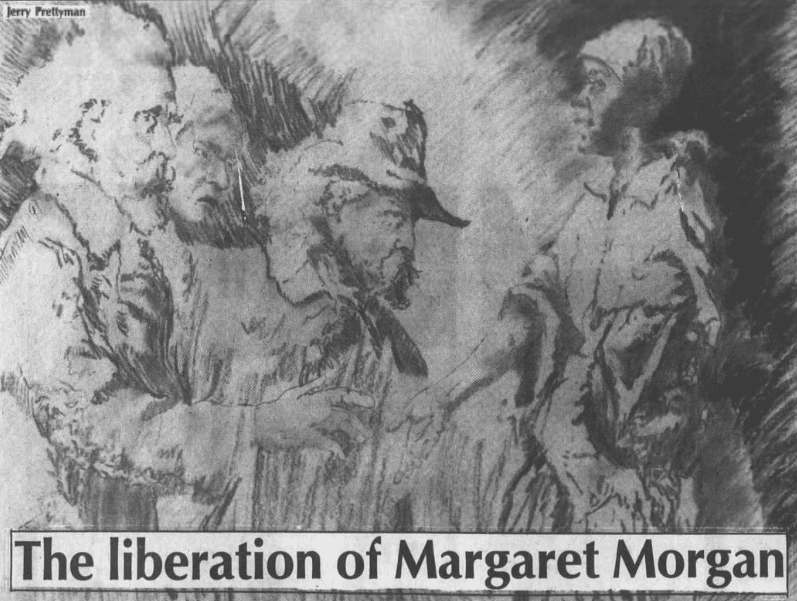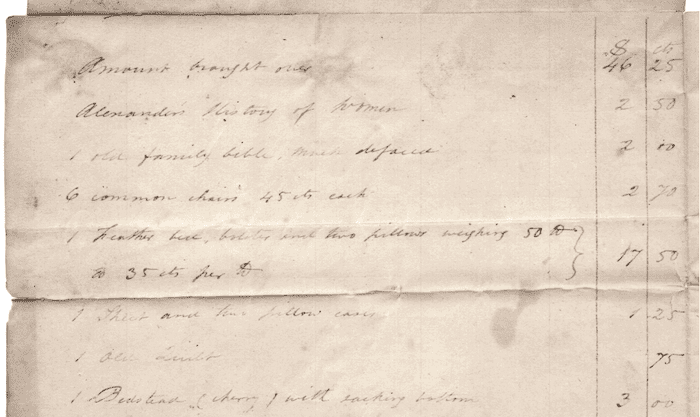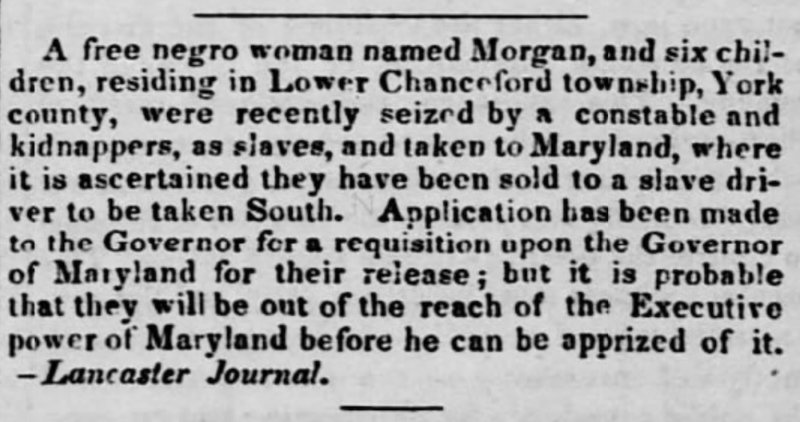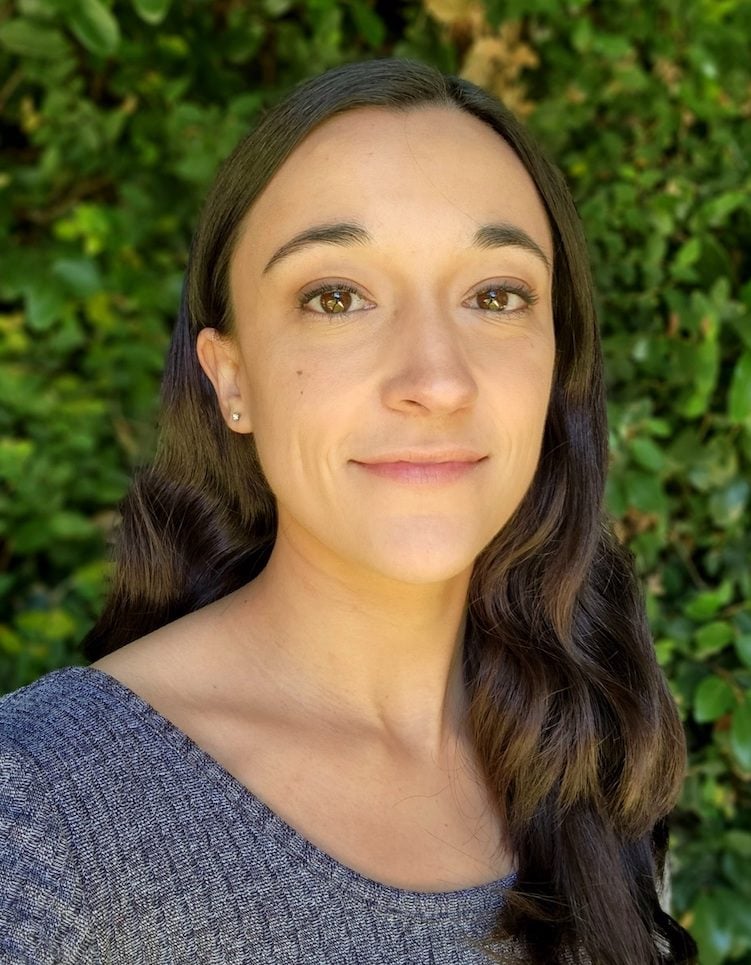The Fate of Margaret Morgan in Prigg v. Pennsylvania

The Liberation of Margaret Morgan, published in The Evening Sun on February 21, 1991. (Source)
February 21, 2024 ~ By Shari Rose
Before the Fugitive Slave Act of 1850 was enacted, the Supreme Court attempted to settle the question of enslaved people who escaped to free states in a case called Prigg v. Pennsylvania. The subjects of that case were a Black woman named Margaret Morgan and her children, who had lived their entire lives as free people. What the Morgan family endured and the legal precedent that was set eight years before the Fugitive Slave Act demonstrate just how quickly hard-fought civil liberties can be stripped away, particularly when the Supreme Court has the final say.
Margaret Morgan Marries and Moves to Pennsylvania
Margaret Morgan was born around 1800 in Harford County, Maryland. Her parents were owned by a man named John Ashmore, who effectively freed them from service before Margaret was born. Though no official manumission, or the act of freeing slaves, was ever documented for her family.
In the 1820s, Margaret married a free Black man named Jerry Morgan. The couple remained in the Dublin District of the country, near the area where Ashmore lived. The Morgans started a family of their own and lived a life that was by all appearances, free from slavery. In fact, when John Ashmore had his property’s full inventory legally recorded in 1824, neither Margaret nor her parents were included on the list.

John Ashmore’s inventory documents from 1824 show Margaret Morgan was not part of his property. (Source)
In 1832, the Morgans moved to Pennsylvania. Ashmore made no attempt to retrieve Margaret or her children. He did not issue any runaway slave advertisements or produce any sort of public effort to bring them back to Maryland. It’s likely that Margaret and Jerry Morgan wished to raise their children away from the horrors of slavery, and moved to a somewhat safer state like Pennsylvania, where slavery had been abolished. The couple then had one more child, born free in the state.
- More stories: Reckless Eyeballing: How Matt Ingram’s Story Reveals Fear of Black Sexuality
- More stories: Esther Jones: Betty Boop’s Original Influence
- More stories: How Enslaved Africans Carried Rice Seeds in Their Hair to the New World
Ashmore Pursues the Morgans Across State Lines
It’s believed that John Ashmore talked about freeing all his slaves before he died, but he only completed the manumission documents for six of them, and Margaret was not one of them. After his death around the mid 1830s, Ashmore’s widow signed off on her newly inherited estate’s inventory. Margaret Morgan was not listed as part of the Ashmore’s property in that document.
But in 1837, that suddenly changed. Margaret Ashmore, who was one of John’s living family members (historical records regarding her identity are unclear), decided to pursue Margaret Morgan and her children across state lines to force them into slavery, and likely sell them to a new slave owner.
She hired Nathan Bemis and Edward Prigg to find the Morgan family in Pennsylvania. They then recruited two other white men to join their posse. These men successfully secured a warrant from a Pennsylvania justice of the peace named Thomas Henderson to capture the family.
Abduction of Margaret Morgan & Her Children
The posse entered the Morgan’s home in the middle of the night and dragged the family into an open-air wagon. When Bemis, Prigg, and rest of the posse arrived at Henderson’s home with Margaret, Jerry, and their six children, Henderson “refused to take further cognizance of the case.” It’s likely that Henderson realized what he allowed to take place that night was in violation of an existing civil liberties law, and wanted no further part in the scheme.
Much to their dismay, the posse could not find a judge who would grant them the ability to transport this family across state lines into Maryland, so they had no choice but to release the Morgans. Instead, the men waited until Jerry Morgan was out of the home for the day, and abducted Margaret and her children.

A March 31, 1837 excerpt taken from The Liberator, abolitionist newspaper, that records the kidnapping of Margaret Morgan and her children. (Source)
- More stories: The Triumphs of Edward Gardner at the 1928 Bunion Derby
- More stories: John Mitchell Jr.’s Relentless Fight for Justice at The Richmond Planet
- More stories: Zazu Nova’s Legacy At The Stonewall Riots
Legal Battle Brews Between Pennsylvania and Maryland
Margaret Morgan and her children were taken before Harford County Judge Stevenson Archer, who sanctioned the sale and forced them into slavery. While his wife and children were placed into bondage in Maryland, Jerry Morgan worked to lobby Pennsylvania’s anti-slavery governor to intervene.
After a trip to Harrisburg, Jerry boarded a boat headed for Columbia, PA on the east bank of the Susquehanna River. But when a white man lost his jacket, the crew and passengers blamed him for allegedly stealing it. Seeking to escape the barrage of violent threats from white passengers, Jerry jumped overboard. He slipped beneath the boat and drowned.
Without her husband to push for her freedom, the fate of Margaret Morgan and her family was left to the mercy of a growing legal battle between states. By abducting Margaret and the kids to force them back to Maryland, Prigg and his posse broke Pennsylvania’s Personal Liberty Law of 1826, which prohibited freed Blacks from being enslaved through the means of transporting them to a different state. All four men were indicted by a Pennsylvania grand jury and headed to trial.
The York County lawyer who prosecuted Prigg and his associates was Thomas Hambly. He argued that Justice of the Peace Thomas Henderson knew he didn’t have jurisdiction to approve the warrant that allowed the posse to kidnap the Morgan family, due to the 1826 law. The state of Maryland contended that this state law violated the federal Fugitive Slave Act of 1793, and could not be enforced.
All four men were eventually found guilty in 1839. However, they appealed all the way to the Supreme Court, who agreed to hear the case in 1842.
Prigg v. Pennsylvania
In Prigg v. Pennsylvania, the Supreme Court reversed earlier court decisions and found in favor of Prigg and the three other men who kidnapped the Morgan family. It determined that Pennsylvania violated the Constitution’s Supremacy Clause by elevating a state law (Personal Liberty Law of 1826) over a federal one (Fugitive Slave Act of 1793).

Lawyer Thomas Hambly’s documents in the Prigg v. Pennsylvania case. (Source)
Additionally, the Court stripped away some provisions of the 1793 law so that states could refuse to help slave owners reclaim runaway slaves within their borders. Pro-slavery groups lambasted what they called an attack on their rights to own people and pushed for stronger enforcement of fugitive slave laws. This led to the creation of the Fugitive Slave Act of 1850, as part of the Compromise of 1850. The act compelled federal judicial officials in all states to assist with returning runaway slaves, even when the enslaved person resided in a free state.
- More stories: Marshall Sherman’s Capture of Virginia Battle Flag at Gettysburg
- More stories: Prison Gerrymandering Is a Modern 3/5 Compromise
- More stories: Echoes of Slave Patrols in ICE Raids: What Abolitionists Can Teach Us
What Happened to Margaret Morgan and Her Children
Very little is known about what happened to Margaret Morgan and her children after the Supreme Court ruled against them. Some accounts contend that they were turned over to Margaret Ashmore, who sold them to new slave owners in Harford County for a quick profit.
A Baltimore-based writer named Margaret Pagan wrote a piece for the Baltimore Sun on February 21, 1991 about what may have happened to Morgan and her children. After combing through Harford County records, Pagan found a 1857 advertisement from Harford County slave owners. It offered a $2,000 reward for the return of four enslaved men, including a 21-year-old named Edward Morgan. It’s very possible Edward was one of Margaret’s children, but this has never been confirmed.
According to Pagan, all public records about the Ashmores end after 1830. Edward Prigg became a constable, or police officer, then was nominated for sheriff in 1840.
- More stories: How a Retractable Syringe Exposed Powerful Group Purchasing Organizations
- More stories: The Forgotten Anti-Filipino Watsonville Riots of 1930
- More stories: Lucy Hicks Anderson: Black Transgender Pioneer of the 1940s
Aftermath of Prigg V Pennsylvania
An important and baffling piece of the SCOTUS decision in Prigg v. Pennsylvania that few online sources acknowledge was highlighted by The Liberator, famous abolitionist newspaper, on February 8, 1861. One of the Morgan children was born in the free state of Pennsylvania, yet this child was still forced into slavery by the Supreme Court. As quoted from The Liberator:
“…that if a fugitive slave was permitted…by the indifference of the master, to remain in the State, and a child was born to her after the lapse of a year, that child was a native of Pennsylvania; it never escaped from slavery, and therefore could not be returned. This Mr. Prigg took back Margaret Morgan, and two or three of her children, one of whom, it appeared by the statement of facts in the case, was born over a year after the escape of the mother into Pennsylvania; but you may read through the decisions of those seven judges-each one giving an opinion – and you will not find one word that alludes to that child! She is given up as though she were a piece of waste paper, not worth considering … she was given up unregarded like her mother’s shawl or shoes. Not one of the judges of the United States Court, through the whole of these lengthened decisions, deemed the principle worth a line – not a word!”
After the Supreme Court’s 8-1 decision, Margaret Morgan and her family lost everything. For most, if not all, of Margaret’s life, she lived as a free woman. She loved who she wanted, started the family she wanted, and lived where she wanted. That was all wiped away in large part because a white slave owner wanted to make a quick profit, and the Court made it possible.
Not only that, but all her children, who had never been enslaved, were sold into bondage, including one child who was born free in a free state. Their humanity and their rights never entered the equation.
As we hurtle toward another election year with a Supreme Court that’s shown it has no qualms with taking away generations of established rights in a single decision, let us take note of how quickly these hard-fought freedoms are lost when the interests of the wealthy come in direct opposition to the civil liberties held by the rest of us.
- More stories: Jovita Idár’s Fight for Mexican-American Rights in Texas
- More stories: Martha Mitchell Was Right About Watergate
- More stories: How School Portables Became Permanent Classrooms






0 Comments